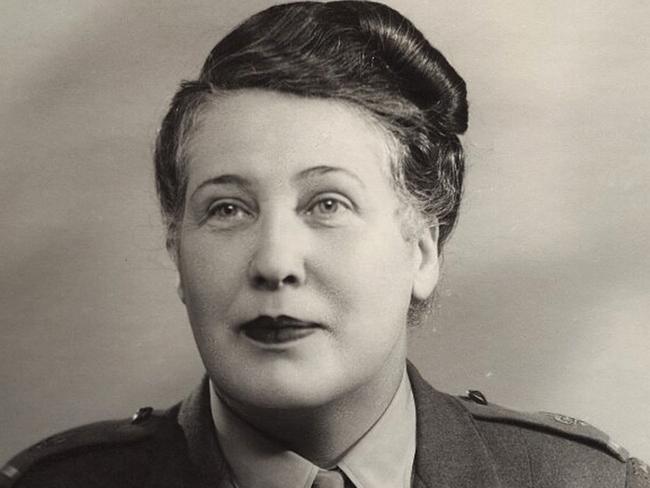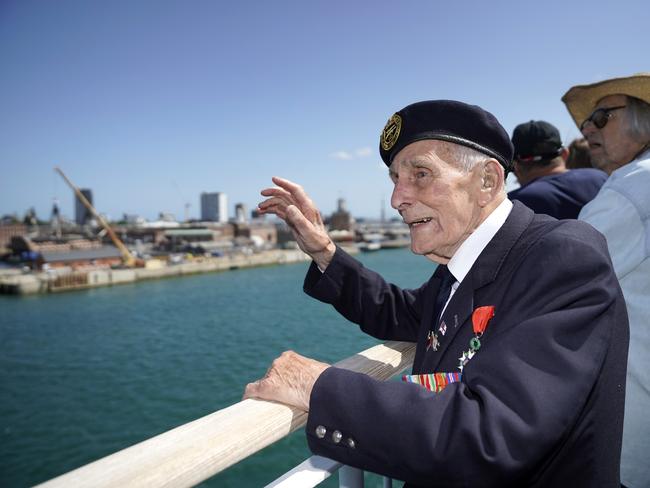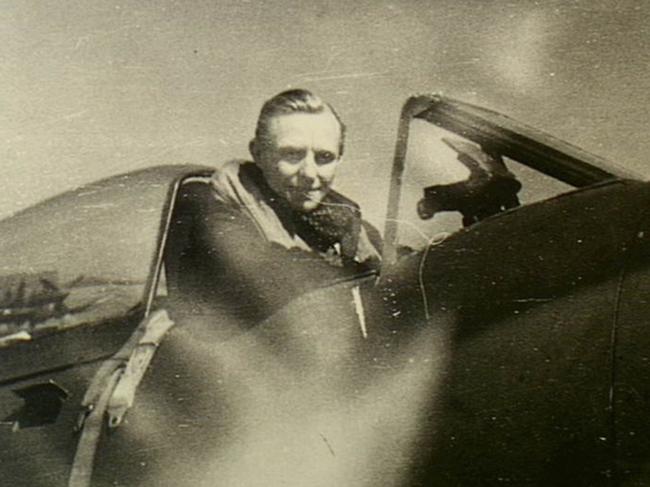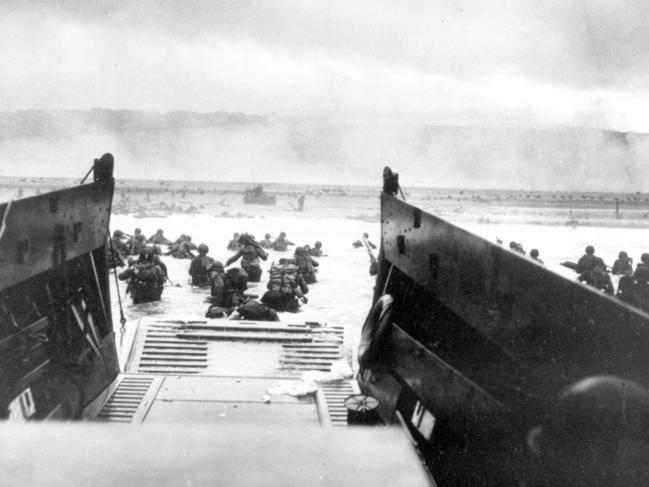Australia’s D-Day heroes revealed
From a Gallipoli veteran and his footy player comrade, to a WW1 Anzac’s widow who became a WWII heroine, these are the unknown stories of Australians at D-Day.
On April 25, 1915, 16-year-old George Dixon waded ashore through the pre-dawn darkness at Gallipoli, in a seaborne landing that is etched into Australian history.
The underage Anzac (he had lied about his age to enlist) from Tasmania would last seven days in that hellish struggle for a foothold on enemy soil, before being badly wounded and evacuated.
Twenty-nine years and six weeks later, Dixon was again bobbing off a hostile shore in the early morning gloom; once more at the centre of a world-changing event.

Now a naval officer captaining a British landing craft, he was part of the greatest invasion armada the world has ever seen — the push to free Europe from Nazi tyranny; D-Day.
As a massive naval and air barrage pounded German positions along the Normandy coast in France on June 6, 1944, vessels like Dixon’s surged through terrifying enemy counter-fire to discharge their loads of men and tanks into action.
In action close by, off the beach codenamed Juno, Dixon’s fellow Aussie Richard Pirrie — a former Hawthorn footy talent seconded to the Royal Navy — was also commanding a landing craft.

The two men had taken part in the Allied landings at Sicily a year before so had experience; and both would be recognised for their actions on D-Day. However sub-lieutenant Pirrie’s mention in dispatches for “gallantry, leadership and determination” would be posthumous: his craft was hit and he was killed, his body never recovered — the first Australian to die on D-Day.
An unfinished letter he penned to his family just before read:
My dearest Mother, Dad, and the boys. Well, my dears, the pressure is on now and as soon as the weather improves we sail for the greatest event in the history of the world. By the time you receive this you will surely have heard some of the bare details. This is the greatest Armada that ever was formed. A colossal feat of organisation; the product of years of planning and hard work.
His words were true.


As the Canadians in Pirrie and Dixon’s spearhead fought their way onto Juno beach, up and down the Normandy coast the struggle was replicated: British soldiers at Gold and Sword; US units on Utah and Omaha beaches — around 150,000 men.
Inland, paratroopers and glider troops landed the night before, many of them by Aussie pilots, were fighting in ragtag bands. Above, almost 8,000 bombers and fighters pounded and strafed the German defences; and out to sea, a mighty fleet of 5,300 ships bombarded strongpoints and ferried men and supplies.
Among them were 3,300 Aussies, the majority RAAF crews or seconded to Royal Navy ships, with a handful of infantry attached to Commonwealth units. All doing their bit to ensure this daring strike didn’t end in disaster — which it could have. Hitler’s forces, who had spent months waiting for this moment behind their so-called Atlantic Wall of fortifications, aimed to hurl the Allies back into the sea and in at least one location — Omaha beach, as portrayed in the epic film Saving Private Ryan — almost did. The Supreme Commander of the Allied Expeditionary Force and later US President Dwight Eisenhower was well aware the mission could fail, and had even written a note accepting full responsibility should that happen.
“The troops, the air and the Navy did all that Bravery and devotion to duty could do. If any blame or fault attaches to the attempt it is mine alone.”
Australian War Memorial military historian Dr Lachlan Grant points out that had D-Day been a defeat, Britain’s military would likely never have recovered and the US would have been massively impacted — and Australia would have been “one of the very liberal democracies in the world left standing.”
“This is what most of the world enjoys today, our rights to vote in elections, our religious freedoms,” he adds. “That is very much what the war was about”.
Europe would have remained under the Nazis, with the only (slim) hope of “liberation” from Stalin’s Soviet Union — another brutal regime. And Japan could have been emboldened.

“The world would have been very different,” says Dr Grant. “We were very much part of the British Empire so if Britain had lost, we would have been very much alone ourselves.”
So for all those fighting on June 6, this was a truly desperate day. The sacrifices were many and would only continue as the ten-week battle to control Normandy dragged on, with a daily casualty rate worse than many of the most notorious First World War battles.
It was in the air that Australia was the most represented, with 12,400 Royal Australian Air Force crew stationed in the UK by mid-1944 and thousands more serving through the Royal Air Force and in their own squadrons — and it was in the air that Australia suffered the worst.
“June ’44 is the worst month for casualties in the RAAF’s history,” says Dr Grant.
Among them were men like NSW Typhoon fighter pilot Donald William Mason, shot down on June 18 in a mission against German flak batteries near Caen. His remains were not recovered from the fuselage for 48 years, when he was finally buried with full honours at a war cemetery in France.
There were far fewer Australians on the ground: 13 Australian Imperial Force officers seconded to British units to gain experience ahead of expected seaborne assaults on the Japanese and an unknown number who may have enlisted directly into British units — plus a similarly unknown number of men who would become Australians after the war, emigrating for a new life.

Among the few, however, were notable standouts — and not all were soldiers.
The famous war broadcast correspondent and Kokoda veteran Chester Wilmot who landed with British glider shock troops in the early hours of 6 June 1944.
“With grinding brakes and creaking timbers we jolted, lurched and crashed our way to a landing,” he reported for the BBC. “We shouted with joy and relief and bundled out into the field.”
And a story only just coming to light, thanks largely to the efforts of Dr Grant, is that of Sydney’s extraordinary Olive Sherington. A former British army nurse in WW1, she married an Anzac and moved Down Under.
When WWII broke out she was a widow, now on holiday in Europe. She joined Britain’s Mechanised Transport Corps as a driver, serving in France in 1940, where she is believed to have been the last servicewoman evacuated, after Dunkirk had fallen to the Germans (she drove a lorry of wounded men to Bordeaux, just ahead of the surging enemy, where they were picked up by a destroyer). Four years later, having driven an ambulance in the Blitz in the meantime, she was one of the first Allied servicewomen back on French shores.
After June 6, it will be another ten months before Germany surrenders; increasing numbers of Australians are drawn in, many of them discovering new horrors along the way: Sherington is at the liberation of Belsen concentration camp, while Aussie Flying Officer Kenneth Collier becomes the first pilot to knock out one of Hitler’s horrific “superweapon” V-1 rockets by using his wingtip to flip it, having run out of ammunition.
And of course Japan fights on until August.
With campaigns like Kokoda and Borneo; and ordeals like Hellfire Pass and the Sandakan Death March etched into the Australian story, it is little wonder that Japan is often considered our country’s “real” enemy in the Second World War.
Yet as Lachlan Grant points out, the same number of Australians died fighting Germany and fascist Italy across Europe as in Asia against the Japanese — more than 9,000 in each case. From April to August 1944, 1,117 Australians died in operations to liberate France.
Australia joined the conflict by declaring war on Germany, not simply due to its ties with Britain and empire but because, in the words of Prime Minister Robert Menzies, if Hitler’s aggression went unchecked “there could be no just peace for the world”.
That is why we remember June 6, 1944.


